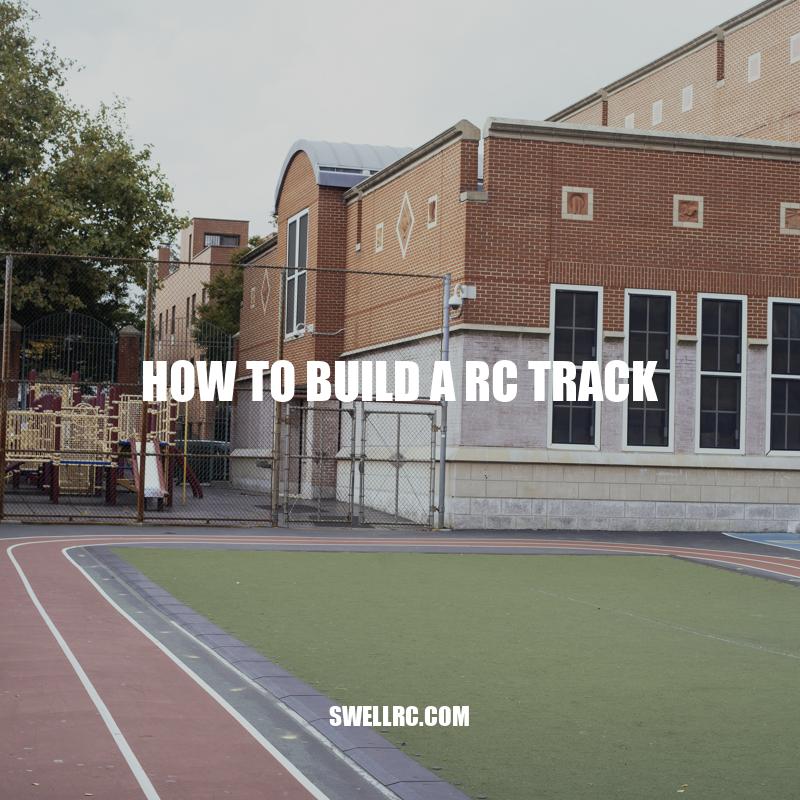How to Build an RC Track: Step-by-Step Guide.
Building your own RC track can provide tremendous enjoyment for you and other RC enthusiasts in your community. Not only does building an RC track give you the opportunity to exercise your creativity, but it can also lead to the development of new skills. However, as with any project, building an RC track requires careful planning and attention to detail. From selecting the perfect location to purchasing the right equipment and materials, every step in the process is critical to the overall success of the project. In this article, we will provide a step-by-step guide on how to build an RC track for either racing or freestyle jumping. Whether you’re a seasoned hobbyist or a beginner, this guide will help you create a successful RC track that will bring endless hours of fun for years to come. So, let’s get started!
Choosing the Location
Choosing the right location for your RC track requires careful consideration. Here are some things to keep in mind:
– Look for a **flat surface** with a **minimum of 30 feet by 30 feet**.
– Ensure there’s enough space for a **pit area** and **spectator seating**.
– Choose a location that is **easily accessible**, **secure**, and **well-drained**.
– An ideal location could be your backyard, an open field, or a vacant parking lot.
Once you have selected the location, it is time to focus on the design of the track. There are numerous resources available to help you with this process. Websites such as **RC Universe** and **RC Driver** have a wealth of information on track design, including suggestions for different layouts and obstacles you can include. Additionally, companies like **RC Tracks of Las Vegas** offer a variety of services including track design and construction, as well as providing equipment and materials to get your track up and running.
How much space do I need for an RC track?
The amount of space needed for an RC track depends on a variety of factors, including the type of RC vehicles you plan to use and the layout of the track itself. Generally speaking, you’ll need a relatively flat, open area with plenty of space to accommodate the track as well as any additional features you want to include (such as jumps, turns, and obstacles).
Some things to consider when choosing a location for your RC track include:
- The size of your vehicles – larger vehicles like 1/8-scale buggies will need more space than smaller 1/10-scale vehicles
- The layout of the track – different track designs will require different amounts of space
- The level of skill and experience of the drivers – beginners may prefer a smaller track with simpler features, while more experienced drivers may want a larger, more challenging track
- The availability of power sources and other amenities (such as restrooms) nearby
If you’re not sure how much space you’ll need, the best way to determine the optimal size for your RC track is to consult with an experienced RC racing hobbyist, or to visit an RC track and observe how much space is used and how it is being utilized.
Before beginning construction, it’s essential to prepare the area properly. Here are the steps you should follow:
|Step|Details|
|— |— |
|1| Clear the area of any bushes, rocks or debris.|
|2| Level the track with a bulldozer or a shovel.|
|3| Mark the track with stakes, cones or spray paint.|
|4| Plan for enough space for pit area and spectator seating.|
It’s important to note that prior to ground-breaking, you’ll need to check with local authorities and permit requirements. In some cases, you may also need to seek approval from a neighborhood association or planning board. Failure to obtain the necessary permits could result in substantial fines or even legal action.
For additional information on preparing your RC track area for construction, websites like RC Car Action offer tips and suggestions to help you get started.
What Needs to be in Place Before Construction Begins?
- Building plan approval by relevant authorities
- Written contract or agreement with the construction team
- Procurement and delivery of the necessary materials
- Open communication between stakeholders
- Site preparation, including clearing and leveling
- Establishment of a timeline and budget
### Purchasing the Necessary Materials
Now that you have chosen the location and planned the design of the RC track, it’s time to purchase the necessary materials. Here are some of the items you’ll need:
– **PVC pipe** in various sizes.
– **Concrete mix**, **sand**, and **gravel**.
– Tools such as **saws**, **hammers**, **drills**, and **levels**.
– **Gloves**, **goggles**, and other protective gear.
– **Tarp** for covering the track during bad weather conditions.
Some online stores like [Amazon](https://www.amazon.com/) and [Hobbyking](https://hobbyking.com/) offer a wide selection of RC track construction materials at reasonable prices. Alternatively, you can visit your local hardware store to purchase these items.
It’s important to note that the quantity of materials needed will vary depending on the size of the track and the complexity of the design. Therefore, it’s essential to plan accordingly and ensure that you don’t run out of materials midway through construction.
For additional information on where to purchase supplies to build your own RC track, websites like [RC Driver](https://www.rcdriver.com/) and [RCTech](https://www.rctech.net/) provide links to reliable online stores and specialty shops in your area.
How big should an RC track be?
Here are some general guidelines you can follow when determining the size of an RC track:
- Indoor tracks: These tracks are typically smaller, around 20 x 40 feet, due to space limitations. They may also have tighter turns and shorter straightaways.
- Outdoor tracks: These tracks can range anywhere from 50 x 80 feet to 100 x 200 feet or more. The size largely depends on the type of vehicles being used and the skill level of the drivers.
- Tracks for 1/10-scale vehicles: These tracks are typically smaller, around 80 x 100 feet, as the vehicles are more agile and can handle tighter turns.
- Tracks for 1/8-scale vehicles: These tracks require more space, around 100 x 200 feet or more, as the vehicles are larger and faster.
It’s essential to consider the type of RC vehicles you’ll be using, as well as any other factors like budget, terrain, and audience, to determine the ideal track size for your needs.
If you’re looking for more information on RC tracks or want to purchase one, check out websites like Horizon Hobby, RC Planet, and Amain Hobbies.
Sure, here’s an example:
### How to Make the Best Coffee at Home
Are you tired of spending money on mediocre coffee? With these tips, you’ll be brewing the best coffee in no time.
First, invest in a **high-quality coffee maker**, such as the [Breville Precision Brewer](https://www.breville.com/us/en/products/coffee/bdc450.html “Breville Precision Brewer product page”). This machine allows you to customize a wide range of brewing options, ensuring the perfect cup every time.
Next, choose **fresh, high-quality beans**. Look for beans that have been roasted within the past two weeks and are labeled with the roast date. Fresh beans will have a rich aroma and unique flavor profile.
When brewing, use **filtered water** to avoid any impurities that might affect the taste of your coffee. And remember to use the appropriate water-to-coffee ratio (usually 1:15) for best results.
Finally, try experimenting with different brewing methods, such as **pour-over** or **French press**. Each method extracts a unique flavor from the beans, giving you a variety of options to choose from.
With these tips and a little practice, you’ll be brewing the best coffee at home and saving money in the process.
How big does an RC track need to be?
RC tracks come in various sizes and shapes, depending on the type of RC cars that will be used. Here are some general guidelines:
- Indoor tracks: typically range from 10’x20′ to 30’x60′
- Outdoor tracks: can range from 100’x100′ to over 200’x400′
- Off-road tracks: tend to be larger than on-road tracks due to jumps and obstacles
These are just guidelines, as the size of the track will ultimately depend on the available space and the preferences of the track builders and users. For more specific recommendations, consult with RC hobbyist communities or visit websites such as rcplanet.com or amainhobbies.com.
### Adding Final Touches
Once the construction of the track has finished, it’s time to put some finishing touches such as:
#### Platform and Pit Area
Constructing a platform or pit area will provide drivers with a comfortable, organized space to store their cars and equipment. Additional features to add to the platform or pit area are benches, tents or umbrellas.
#### Lighting
Lighting can improve the visibility for both drivers and spectators, allowing for night events. You can use temporary LED floodlights or install permanent poles around the track area.
#### Signage and Sponsor Logos
If you plan on hosting events or inviting other drivers, you may want to add signage or sponsor logos to the track. You can use retractable banners or decals to make the track look more professional.
Various stores like HobbyTown or Tower Hobbies offer a wide range of products for RC tracks, including durable track markers, banners, and LED floodlights. By adding final touches, you can make your track look professional and ready to host events.
What are the parameters of pit design?
There are various parameters that need to be considered for designing a pit, including:
- Size and depth of the pit
- Location of the pit
- Surrounding soil structure
- Drainage and water accumulation
- Use of the pit (storage or disposal)
- Construction materials
- Environmental regulations and permits
It is important to consult with a professional engineer or geologist before designing a pit to ensure all parameters are taken into account.
### Testing the Track and Conclusion
Once you have completed the track construction and added the final touches, it’s time to test the track. Running an RC car or bike around the track is the only way to understand how it feels and identify any issues.
Expect some initial setup and configuration using this checklist:
– Make sure that all the corners are smooth and easy to navigate.
– Check that the jumps or obstacles are clean, aligned, and secure.
– Inspect the track’s foundation for stability, especially after dry or wet weather conditions.
If drivers report a particular difficulty in a specific turn or section, analyze the track layout, and make any changes as necessary. As with any construction project, a few adjustments may be necessary to achieve optimal performance.
In conclusion, building an RC track is a fun and rewarding experience that requires careful planning, consideration to materials and equipment, and collaboration with fellow RC enthusiasts. By following these steps and working closely with your RC group, you can create an enjoyable environment to spend time with friends and family, and even host competitive events.



